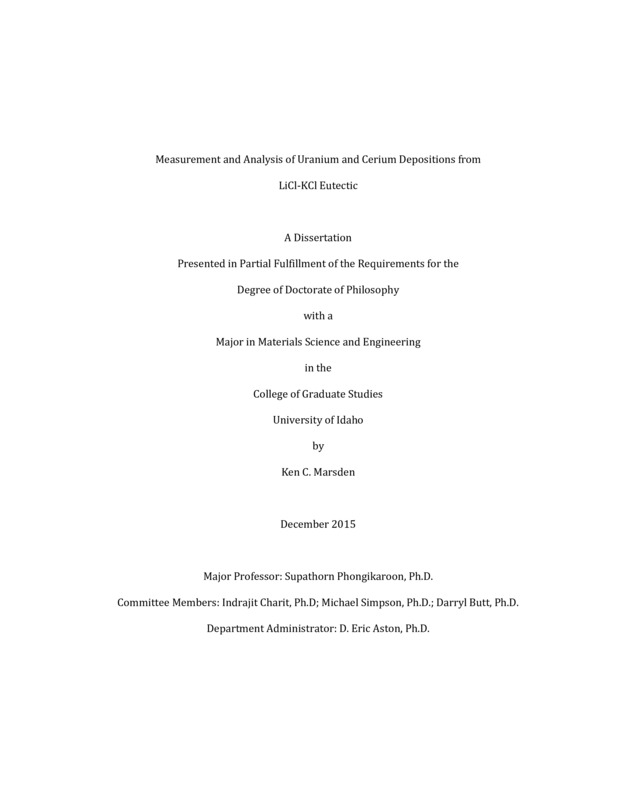Measurement and Analysis of Uranium and Cerium Depositions from LiCl-KCl Eutectic
Marsden, Ken C.. (2015). Measurement and Analysis of Uranium and Cerium Depositions from LiCl-KCl Eutectic. Theses and Dissertations Collection, University of Idaho Library Digital Collections. https://www.lib.uidaho.edu/digital/etd/items/marsden_idaho_0089e_10753.html
- Title:
- Measurement and Analysis of Uranium and Cerium Depositions from LiCl-KCl Eutectic
- Author:
- Marsden, Ken C.
- Date:
- 2015
- Embargo Remove Date:
- 2018-01-19
- Keywords:
- Cerium LiCl-KCl pyroprocessing Uranium
- Program:
- Chemical and Materials Science Engineering
- Subject Category:
- Materials Science; Nuclear engineering
- Abstract:
-
Molten salt electrorefining of uranium is an important recycling technique to potentially recover re-usable materials from used nuclear fuel. The purity of the recovered uranium product is one of many important considerations which can impact the value of such recycling. Two primary groups of contaminants are often the most widely considered: actinoid species, such as plutonium and neptunium, and lanthanoid species, such as cerium, lanthanum and praseodymium. The present study investigated fundamental and applied factors important to this subject and laid groundwork for additional future studies.
A detailed literature survey of the primary electrochemical properties of the actinoid and lanthanoid species was performed. Detailed electrochemical studies of cerium in LiCl-KCl eutectic were performed, including measurement of Apparent Standard Potential and diffusion coefficient by several techniques across a wide temperature range. The nucleation mode of cerium was determined to be instantaneous 3-D nucleation. The exchange current density of cerium was measured with the linear polarization technique.
The purity of uranium dendrites produced under plant conditions in the presence of fission and transmutation products was investigated, and this information was compared against purity of the final uranium product. The results indicate that the intrinsic purity of the uranium crystals is very high, and most impurities in final uranium products are very likely a consequence of other process operations.
Laboratory studies were performed with UCl3 and UCl3-CeCl3 mixtures in the LiCl-KCl eutectic. The diffusion coefficient and exchange current density of uranium were measured. The morphologies of uranium crystals created under the conditions of three electrochemical potentials were studied using SEM and found to be significantly influenced by deposition potential. Uranium dendrites were produced across a range of electrochemical overpotentials for a series of 6 electrolyte conditions. No clear relationship was found between cerium contamination of the uranium and the deposition overpotential. However, the cerium contamination was found to rise significantly at all deposition potentials in uranium dendrites produced from electrolytes of low uranium activity.
- Description:
- doctoral, Ph.D., Chemical and Materials Science Engineering -- University of Idaho - College of Graduate Studies, 2015
- Major Professor:
- Phongikaroon, Supathorn
- Committee:
- Charit, Indrajit; Simpson, Michael F; Butt, Darryl
- Defense Date:
- 2015
- Identifier:
- Marsden_idaho_0089E_10753
- Type:
- Text
- Format Original:
- Format:
- application/pdf
- Rights:
- In Copyright - Educational Use Permitted. For more information, please contact University of Idaho Library Special Collections and Archives Department at libspec@uidaho.edu.
- Standardized Rights:
- http://rightsstatements.org/vocab/InC-EDU/1.0/

